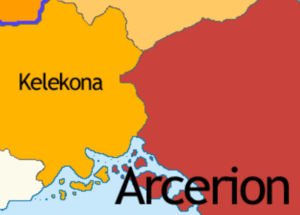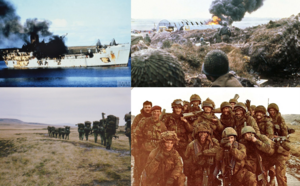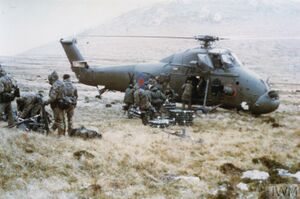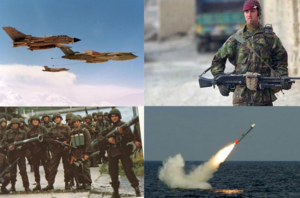Telekonese Conflict
| Telekonese Conflict | |||||||||
|---|---|---|---|---|---|---|---|---|---|
 Arco-Kelekonese Border Region, also known as the Telekonese Lowlands. | |||||||||
| |||||||||
| Belligerents | |||||||||
|
|
| ||||||||
The Telekonese Conflict is an ethnic and territorial conflict between Arcerion and Kelekona over the disputed region of the Innis River Basin and the Dabhóg Wetlands, inhabited by a mixture of different cultural and ethnic groups, but predominantly naturalized Arcers and Kelekonese indigenous peoples. The region is primarily under the control of Kelekona west of the Innis River, but the Telekonese peoples that make up the Southeastern portion of Kelekona are considered a de facto nation and have a diaspora that exists across national boundaries.
The conflicts origins began shortly after the end of the Fourth Bush War and the end of the Kelekonese Civil War, where subversive attempts by Titechaxha and Kelekona to subvert Arcer rule and sovereignty in the Innis River Basin were unsuccessful, as the communist and socialist insurgencies they had sponsored were militarily defeated by the time of the 1975 Gameroun Accords. Repeated calls in the League of Nations and international community by the Kelekonese government to return Telekonese-majority areas of Northwest Arcerion had gone unheeded, and growing frustrations in the Kelekonese government's People's Font's communist leadership meant that their newly acquired sovereignty and power after a devastating civil war was threatened by the existence of Arcer military buildup along the border.
The following series of conflicts were attempts by Kelekona to seize the industrially and economically important Innis River Basin, including the Arcer city of Dunborough, resulting in thousands of military deaths and civilian casualties. This also included the attempts by the Kelekonese government to seize the Foxhey Islands and the disputed areas in the Gibson Gap. Multiple ceasefires and arimstice agreements have subsequently validated Arcer sovereignty, but continued violations have resulted in the ongoing conflict, which has not seen a major outbreak since 2007's escalation. The 2007 conflict resulted in the destabilization of the Yellow Revolution reforms, and the continued slide of Kelekona into sectarian and ethnic infighting amongst rival warlords. This destabilized state has prevented a resurgence in the conflict, although Kelekonan state media consistently blames Arcer involvement, notably the use of the Office of Public Safety and National Security, for the poor state of modern Kelekonese affairs.
Incidents since 2007 are limited, but with Operation REDOUBT and the attempt by Arcerion and the Cape to bilaterally stabilize Kelekona, casualties and attacks against Arcerion have continued to decline.
Background
Arcer settlement and Occidental expansion into the Southeastern Cronan peninsula had forcibly pushed out the Telekonese and Kelekonan Indigenous peoples over two centuries, forcing them to intermix and resettle along Arcerion's Northern and Southeastern border, notably the Innis River Basin and the Washakaran Basin. Kelekona had supported the Fourth Bush War between 1965 to 1974. Notably this manifested in the Operation Kiln and Operation Terrace areas of operation, where the socialist government supported the Free Telokonese People's Movement (FTPM), Telokonan Worker's Army for a Free Crona (TWAFC), and Kelekona supported the Kelekonan Militia for Free Indigenous People (KMFIP). Arming and training these groups covertly had exhausted much of Kelekona's economic and military resources, and after the Gameroun Accords and the armistice, the Kelekonese government sought to again try and liberate and reclaim indigenous Telekonese and Kelekonese peoples settled in the Innis River Basin.
Ethnic conflicts in Northwest Arcerion had long existed between naturalized Arcers, Ardmori migrants, and the Indigenous peoples. Messaging and propaganda by Kelekona had long been aimed at highlighting the supposed oppression of Indigenous minorities, disenfranchisement of native peoples, and the lack of civil rights that the Arcer government afforded to non-white citizens in Norham and Northlea Governorates. Efforts to assist with the creation of non-governmental organizations (NGOs), interfere with local municipal elections, and the creation of support programs for resettlement of Kelekonans to Arcerion had consistently been thwarted by the Office of Public Safety and National Security, as the subversive efforts to undermine the growing Arcosphere were growing amongst the nation's northern border.
By Over the late 1970s and early 1980s, Kelekona had repaired the damage done by the civil war in the country, and focused on improving the instruments of the state, such as its Foreign Affairs and internal security forces. Improvements by the People's Front in government had helped with the establishment with a growing number of militant factions within the government, notably in the General Staff. During this period efforts to expand access to the Gibson Gap and the maritime commercial entrance to Central Crona failed. Dunborough had a monopoly as the main port-of-entry for much of Central Crona, and Kelekonan Ports remained uncompetitive to global markets due to the socialist policies and the traditional proliferation of maritime commerce between Arcerion and major maritime commercial giants such as Burgundie and Kiravia.
In the lead up to the 1986 conflict, Kelekona had been messaging that it had historical claim to the Foxhey Islands and Gibson Gap. It argued that there was shared ethnic and cultural heritage to the port of Dunborough, the mouth of the Innis and Cochrane Rivers, as well as the Gibson Gap and islands that were under Arcer control. A 1985 economic recession had crippled the Kelekonan economy, and looking for a casus belli to seize the economically important Gibson gap and Innis River Basin, it aimed to use this historical ethnic and cultural claim.
Timeline
| 1986 Conflict | |||||||||
|---|---|---|---|---|---|---|---|---|---|
| Part of Telekonese Conflict | |||||||||
 Photos from the 1986 Conflict (Clockwise from top left): An Arco-flagged merchantman burns at anchor after being hit by Kelekonese fire; Kelekonese soldiers witness the aftermath of an Arco airstrike; Members of 2nd Battalion, Royal Arcerion Regiment pose for a photo in the Gibson Gap; Arcerion Parachute Regiment troopers move overland towards Kelekonese positions. | |||||||||
| |||||||||
| Belligerents | |||||||||
|
|
| ||||||||
| Units involved | |||||||||
|
1 Rifle Brigade 7 Rifle Brigade 11 Parachute Brigade 6 Mechanized Brigade |
22nd Motor Rifle Brigade 71st Motor Rifle Brigade 98th Naval Infantry Brigade 112th Presidential Guard Brigade 113th Presidential Guard Brigade | ||||||||
| Casualties and losses | |||||||||
|
224 killed 754 wounded 33 captured |
1,032 killed 1,659 wounded ~5,000 captured | ||||||||
1986 Conflict
Despite warnings by the Office of Public Safety and National Security that included reports of significant troop movements, as well as satellite imagery demonstrating the movement of half a dozen brigades of the Kelekonan People's Army and naval vessels, the Confederate Parliament made no moves to mobilize Arcer Forces. While public support of the government remained high after the nearly decade-long Fourth Bush War, Arcerion was largely still weary of another war and public opinion polls sponsored by some Members of Parliament showed the public was reluctant to engage in another war with their Northern neighbours. Seeing this, the Kelekonese government believed that Arcerion would not defend their islands or seek to retake them militarily. In doing so, the Kelekonan forces believed they could defend their claim in the League of Nations, which would be sympathetic to their historical claim and recognize their sovereignty over the islands.
The Foxhey Garrison was primarily centered around Port Gibson, in Foxhey Governorate. A singular battalion of infantry (3rd Battalion, Norham Light Infantry) was supported by two understrength reserve infantry battalions from the Foxhey Foot Grenadiers. Opposite them was thousands of Kelekonan communist forces, as well as a considerable amount of older Second Great War-vintage ships of the Kelekonan people's Navy, with some modern upgrades purchased in the 1970s. Preparations for landings and rehearsals had been conducted prior in the year in the Kelekonan Islands of the Malentine Sea.
At 4am on the 12th of August 1986, shortly before sunrise, Kelekonan warships appeared off the coast of the Foxhey Islands. Kelekonan forces seized the islands of Sharnwick, Larton, Gramsby, and Swindon. These four islands comprised the largest four islands north of Gibson Island, the largest in Foxhey Governorate. Kelekonan bombers struck the airfields at Port Gibson, and ships shelled the dock facilities and airstrip at Farnsworth. Arcer troops in Port Gibson quickly dispersed after deceiving the news via HF radio that Farnsworth was under attack, moving to positions on the bluffs around Port Gibson to defend it.
The Arcer government was quick to react, and the Confederate Parliament sent diplomatic correspondence to Kelekona informing it that if all forces were not withdrawn in 96 hours, and reparations paid to repair damage and compensate for civilian casualties, then Arcerion would respond with military force. Kelekona did not respond, and the Arcer government began to set conditions to retake the islands. Radio transmissions from Port Gibson to the occupied islands informed them that they would be freed soon, and to shelter in place and cooperate with local authorities and not to resist Kelekonan Forces. Despite this, roughly two dozen Arcer citizens were killed by the Kelekonan People's Army, mostly farmers who attacked Kelekonans with their hunting rifles or through violent protest.
The Arcer General Staff prepared three brigades to seize the islands. 1 Rifle, 7 Rifle, and 11 Para were all moved quickly to Craigfearn and began preparations to retake the four islands of Foxhey. Concurrently, the Arcer Air Force engaged in fierce dogfights over the Gibson Gap, with Arcer fighters and their Kelekonan opponents attempting to gain control of the skies. The Kelekonan fighter aircraft, of older make, were outmatched by the Arcer fighters, however damage by a surprise naval attack at night and shore bombardment by the Kelekonan Navy on the Port Gibson airfield forced Arcer sorties from the mainland, whereas Kelekonese pilots sortied from islands in the Gap itself. The pitched battles were key to prepare for the island landings, and eventually the Arcer Air Force regained control of the skies, despite some losses in pilots, aircrew, and air frames. Fighter bombers spent the rest of August and much of September striking Kelekonan locations on the islands, landing sites, and resupply vessels, attempting to pin and isolate occupying forces. The Royal Arcerion Naval Service during this time conducted sorties, with the Royal Arcer Submarine Service working to strangle Kelekonan commerce, with surface vessels blockading the Warrington Strait and preventing any Kelekonan-flagged vessel from entering the Malentine Sea, and seizing any attempting to leave.

Over the course of October and November, Arcer infantrymen, supported by light artillery, close air support, combat engineers, and naval gunfire landed on the islands over a series of weeks and retook them from Kelekonan control. Kelekonan forces, facing starvation, harsh Northern Malentine conditions, with cold rains and night temperatures ranging from 0-5°C had low morale and were short on supplies. Arcer infantry, under these adverse weather conditions, methodically cleared each island, liberating hamlets and villages of Arcer fishermen and citizenry, who welcomed the Arcer forces with flowers and warm food. Conditions on the island during November had continued to become worse, with cold rains and high winds making helicopter-borne resupply to the Arco forces on the islands increasingly difficult. Losing the grip on the islands, and fighting a rising unpopular public outcry on the home front, the People's Front decided to attack via mainland Arcerion to seize the key Northern port of Dunborough. Arcer forces however had been pre-positioned along the Innis River Basin. Two elite brigades of the Kelekonan People's Army, the 112th and 113th Presidential Guard attempted to cross into Arcerion and seize Dunborough, however Arcerion's 6 Mechanized Brigade had been dug in, and conducted a successful defence of the northern portions of Norham Governorate, and even conducted two successful counterattacks across the river, pushing to the suburbs of the Kelekonan town of Bambara, with multiple squadrons from the Arcerion Mounted Rifles routing their Kelekonan counterparts.
With the Gibson Gap liberated, and their attack on Dunborough an abject failure, Kelekona requested that the League of Nations negotiate an armistice. The United Republic of Alstin acted as a negotiating intermediary between the two nations. An initial ceasefire was agreed upon in the first week of December, with both sides halting offensive actions and Arcer forces withdrawing from Bambara and back into their sovereign borders. The negotiations ended with the pre-conflict borders reaffirmed by both sides, and Arcer forces spent Christmas with the local populace in Foxhey, with many soldiers welcomed into the small hovels and fishing homes of local families for Christmas Dinners. Modern traditions for the Royal Easthampton Borderers still include fish served at the Christmas Mess Dinner to honour this achievement. Arcer casualties had not been light, and the 33 soldiers captured by Kelekonese forces were returned on New Year's Day as part of a prisoner exchange, that occurred in Riverton, Alstin, with the Arcer Air Force flying the troops home the following week to be reunited by their family. In Kelekona, the result of the war's outcome and the economic recession's continuance resulted in the 1988 military Junta's coup d'etat, which was widely speculated to be sponsored covertly via Arcerion's Office of Public Safety and National Security as retaliation for continued communist attacks on Arco sovereignty.
| 1991 Conflict | |||||||||
|---|---|---|---|---|---|---|---|---|---|
| Part of Telekonese Conflict | |||||||||
 Photos from the 1991 Conflict (Clockwise from top left): Arcer Air Force fighter bombers conduct an air-to-air refueling; An Arco paratrooper patrols a small town near Oakham during a clearance patrol in September 1991; Kelekonan Junta forces pose for a photo near Westchester in October 1991; A land-attack cruise missile is fired by the HMS Venture against a Kelekonese Command Node during the last weeks of the conflict as Arcerion counterattacked. | |||||||||
| |||||||||
| Belligerents | |||||||||
|
|
| ||||||||
| Units involved | |||||||||
|
1 Rifle Brigade 4 Mechanized Brigade 5 Mechanized Brigade 6 Mechanized Brigade 11 Parachute Brigade Various Reserve units |
11th Motor Rifle Brigade 14th Motor Rifle Brigade 24th Motor Rifle Brigade 25th Motor Rifle Brigade 48th Mechanized Brigade (National Guard) 50th Mechanized Brigade (National Guard) | ||||||||
| Casualties and losses | |||||||||
|
119killed 341 wounded 76 captured |
~2,359 killed +4,500 wounded ~8,700 captured | ||||||||
1991 Conflict
With the new military junta installed as of 1988, the right-wing government had begun to consolidate power and purge dissidents. Secret courts and tribunals, executions, and politically-motivated imprisonments meant that the nation had begun to resent the new government. Mass protests from labour unions and socialist university students were met with violent crackdowns, and public outcry continued to mount. The League of Nations had condemned the violent suppression of dissent, but the new Junta did not heed their warnings. Arcerion, still wary of Kelekona from the 1986 conflict, had ceased diplomatic relations with the country, however it maintained a small consular staff in Maktalin to negotiate certain economic and diplomatic initiatives. Over three-quarters of energy in Eastern Kelekona was supplied by Arcer's power grid, and much of the finished goods and high end commercial grade products such as electronics and cars were imported from Arcerion. Kelekona's eastern Occidental neighbour also had a significant amount of access and control over fresh water resources, as Arcer corporations and water treatment facilities provided a high percentage of the potable and drinkable water to Kelekona. The junta was also concerned with the outflow of a Kelekonan intelligentsia, or 'brain drain,' caused by the domestic actions of the security forces.
Arcer Under the leadership of Lieutenant-General Tyro K'lyu, the head of the military government, plans and assessments began to be formulated for the seizure of upper portions of the Innis River, to attempt to force the Arcer government to negotiate for more favourable energy and economic terms. Doing so would also attempt to seize two key objectives - the Dunborough Nuclear Power Plant (DNPP) and the Coal-fired power plant in Oakham. These two cities combined would help with energy self-sufficiency as Kelekona had an energy deficit. Plans were for a quick offensive, seizing the two powerplants, as well as the junction of the North Innis and Innis Rivers, which would help to leverage the lowland terrain. Plans included the government of Titechaxha engaging Arcerion diplomatically to assist with the Kelekonese claim that these lands were part of ancestral Kelekona, and they had cultural and historical claim to them.
Arcerion's intelligence services had identified the areas where they had failed to influence the government during the 1986 conflict, and the Confederate Parliament was quick to instruct the Arcer General Staff to prepare, and plans were drawn up. Initial estimates mistakenly included Dunborough as one of the targets, a holdover from the assessment that Kelekona wished to seize the port.
Arcerion moved five Regular Army Brigades quietly up to the Northwestern border, with 1 Rifle digging in defensive positions around Oakham, and 4 Mechanized around Westchester. Other units prepped for counter-attacks and follow-on actions, with 11 Para linking up with Air Force strategic and tactical airlift assets in Dalton, and 5 and 6 Mechanized Brigades in an assembly area near the banks of the Leigh River. The plan by the Arcer General Staff was to conduct a flexible defense-in-depth.
The Arcer government announced on 27 August that they were aware of the Kelekonan Army's preparations, and informed Kelekona that if they were to continue then there would be an appropriate military response. Kelekona, now realizing they had lost the element of surprise, rushed the final preparations of the invasion, which affected the ability of their Brigades to properly prepare and coordinate.
Just prior to dawn on August 29th, Kelekonan units of the 11th and 24th Motor Rifle Brigades engaged Arcer static positions with artillery. However due to the lack of operational surprise, the Arcer units had spread out, and the artillery had little to no effect, instead just causing minor civilian casualties amongst the local population. The two brigades rolled across the line of departure and crossed bridges near Oakham and on the Innis River, and engaged elements of 1 Rifle Brigade along the Oakham Defensive Line. The previous 24 hours had seen Reserve units in Oakham assisting with the construction of defensive fighting positions, evacuating civilians, and assisting civil authorities with preparations for an enemy advance. Long columns of civilian vehicles along Interstate Highway 11 fleeing the fighting would continue for days, as the Royal Arcerion Regiment had to conduct the difficult task of both delaying the Kelekonan forces advancing on Oakham from two directions. Notable was the defense of the historical Firebase Emily, a military base from the Fourth Bush War, by a combined unit of reservists from the Princess of Kilkken's Own Regiment (PKOR) against two motor rifle regiments trying to seize the junction of the Innis and North Innis Rivers. 1st Battalion, PKOR would resist the Kelekonan forces until relieved in mid-October.
In the South, 4 Mechanized Brigade conducted a desperate defence against Kelekonan forces. Outnumbered 4:1, 4 Mechanized conducted a fighting withdrawal into the town's suburbs, where pre-laid minefields, tank ditches, and the usage of anti-tank guided missiles (ATGMs) had slowed down the Kelekonan forces, who had begun to outstrip their supply lines, which were under fire from Arcer artillery and air strikes. The offensive slowed, and by mid-September, the Arcer General Staff believed the enemy had fought to their limit, and prepared Operation Corbray, their counter-offensive.
Operation Corbray
In the North, 11 Parachute Brigade conducted a major airborne insertion of the entire Brigade, and after seizing the enemy airfield at Tallyibumbera, outflanked the Kelekonan 11th Motor Rifle Brigade, quickly destroying much of their rear echelon formations and enablers (artillery, maintenance, etc).
attempts to gain oakham and westchester major armoured battle north of westchester
2007 Conflict
arcer pre-emptive strikes against kelekonese buildup
opsns activities alleged against senior officials
attack over border fizzles out due to relatively weak post revolution government
Fatalities
include a basic table for military casualties on both sides + civilian
Effects on Civilian Infrastructure
destroyed highways
damaged port facilities
railway repairs
Foreign Involvement
Nations
Titechaxha
Malentina
Istrenya
Arms Suppliers
Varshan
Burgundie
As is it's custom, whenever Arcerion goes to war, Burgundie developed a military aid package. During the Telekonese conflicts this occurred in 1986 and 1991, the aid consisted primarily of various fuels and ammunition. In 2007, the package was substantively broader, also including additional land attack cruise missiles.
In all three cases, a small number of Burgoignesc advisor/observers were on hand with front line Arcer troops but conducted no combat operations. Burgundie also took over Arcer naval commitments in the South Songun and Polynesian Seas to allow for the Royal Arcer Naval Service to send additional ships to the Malentine Sea to fight.